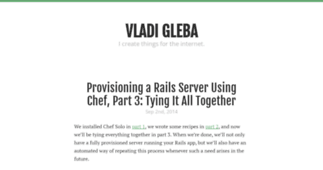Hungry and Foolish
Enter a key term, phrase, name or location to get a selection of only relevant news from all RSS channels.
Enter a domain's or RSS channel's URL to read their news in a convenient way and get a complete analytics on this RSS feed.
Unfortunately Hungry and Foolish has no news yet.
But you may check out related channels listed below.
[...] to be used with a small number of servers. With Chef Solo, you write your recipes on your local computer, upload them to your server(s), and Chef Solo is then called to run them. (A recipe, by the [...]
[...] allowed us to create a specific directory structure on our server and upload a file from our local computer. Neat stuff—and it will only get better. Alright, let’s now switch gears and [...]
[...] in a production environment, unlike WEBrick, which is designed for running your app on your local computer. Because it’s fast, efficient, and offers tons of cool features, like load balancing [...]
[...] ;ll start by creating a file called nginx.conf inside our app’s /config directory on our local computer. Here’s how mine looks like: You might have noticed that the first thing we do is [...]
[...] , they make your recipes readable, and that’s almost worth it on its own. Chef Solo or Chef Server? Chef comes in two flavors: Chef Solo and Chef Server. Chef Solo is a basically a simpler [...]
[...] In part 1, we learned about Chef Solo and used it to create a standard Chef directory structure, along with our own cookbook. Now it’s [...]
[...] most importantly, they make your recipes readable, and that’s almost worth it on its own. Chef Solo or Chef Server? Chef comes in two flavors: Chef Solo and Chef Server. Chef Solo is a basically a [...]
[...] . I never tried MySQL, but when I first started out, I used SQLite, the default database for Rails apps, because I liked its simplicity and saw no need for something more sophisticated. As my needs [...]
[...] Phindee. If you’re not familiar with it, Capistrano is the de-facto deployment tool for Rails apps; it makes deployment easier by automating a lot of the work for you, and it can be easily [...]
I started learning Ruby on Rails over a year ago, and as most beginners, I chose the popular Ruby on Rails Tutorial as my initial guide. Because there [...]
Setting up a Rails server from scratch can be a daunting task. I remember my first attempt; it was a multi-day process full of frustration, things not [...]
[...] called $redis to make it easy for us to access Redis through out our app. Next, we’ll create a new file called search_suggestion.rb inside the /app/models directory. It will contain the [...]
[...] current latest version and update your links accordingly. Initializing the Map Next, we’ll create a free MapBox account and make our own custom-colored map. Once we have the map ready, we’ [...]
[...] using the following command: This will prompt you to enter a new password twice. Next, we’ll create a new group called deployers, which will allow us to easily manage the users with deployment [...]
[...] code. You don’t have to actually create these directories now, as Capistrano we’ll create them itself when it runs. Below is what the rest of the configurations mean: working_directory [...]
[...] I did or my head would’ve exploded). When I finished the book, I decided to build a Rails app called Phindee in order to solidify what I had just learned. I never went back to learn [...]
[...] stderr). Given our configuration, this means that any error messages written by our Rails app to the stderr stream will get written to the .log file specified in the stderr_path. It& [...]
[...] the capistrano-rbenv gem. We can install them by running bundle in the root directory of our Rails app. After Bundler finishes the install, we’ll tell Capistrano to create the necessary files [...]
[...] Last week I wrote about Phindee, a Ruby on Rails app I made to make it easy to discover happy hours in downtown Portland. I quickly mentioned that [...]
[...] to be used with a small number of servers. With Chef Solo, you write your recipes on your local computer, upload them to your server(s), and Chef Solo is then called to run them. (A recipe, by the [...]
[...] allowed us to create a specific directory structure on our server and upload a file from our local computer. Neat stuff—and it will only get better. Alright, let’s now switch gears and [...]
[...] in a production environment, unlike WEBrick, which is designed for running your app on your local computer. Because it’s fast, efficient, and offers tons of cool features, like load balancing [...]
[...] ;ll start by creating a file called nginx.conf inside our app’s /config directory on our local computer. Here’s how mine looks like: You might have noticed that the first thing we do is [...]
Related channels
-
The Hungry and Foolish | The Hungry and Foolish
by Kevin Wild
- The Hub Review
-
Hungry N Foolish | College Startups, Entrepreneurs & Founder Diaries
College Startups, Entrepreneurs & Founder Diaries
- Envato Tuts+ Tutorials
-
Tech|Redefined
Stay Hungry. Stay Foolish.-Steve Jobs

